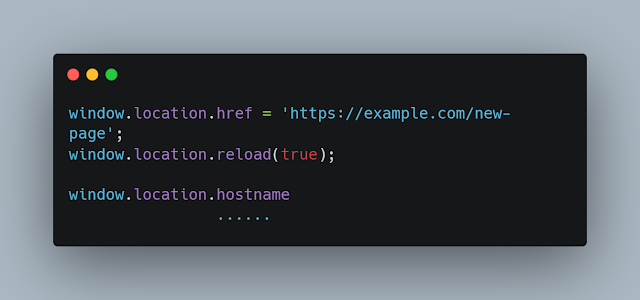Mastering JavaScript Location: A Handy Cheatsheet for Web Developers
| JavaScript Code | Explanation |
|---|---|
window.location.href = 'https://example.com/new-page'; |
Updates the current page URL to 'https://example.com/new-page', effectively navigating to a new page. |
window.location.reload(true); |
Forces a page reload, fetching the content from the server (ignoring the cache) when true is passed as an argument. |
window.location.hostname |
Retrieves the domain name (hostname) of the current URL. Useful for determining the origin of the web page. |
window.location.pathname |
Provides access to the path part of the URL, allowing you to work with it as a string. |
window.location.search |
Extracts and returns the query parameters from the current URL, useful for retrieving specific data or search queries. |
window.location.protocol |
Fetches the protocol (e.g., 'https:') of the current URL, which can be useful for determining whether the page is served securely. |
window.location.origin |
Returns the entire origin of the URL, including protocol, hostname, and port. Useful for constructing new URLs with the same origin. |
window.location.hash |
Retrieves the fragment identifier (hash) portion of the URL, which is often used for navigating to specific sections within a page. |
window.location.assign('https://example.com/new-page'); |
Navigates to a new page by updating the URL similar to window.location.href. |
window.location.replace('https://example.com/new-page'); |
Similar to assign, but it replaces the current page in the browser's history, preventing the user from using the back button to return. |
Introduction
Have you ever found yourself deep in the world of web development, frantically searching for ways to manipulate the current URL in your JavaScript code? Well, you're not alone. Working with the `window.location` object in JavaScript can be a bit tricky, and that's why we're here to provide you with a handy cheatsheet to make your life easier. We'll delve into the nitty-gritty details of `window.location` and explore some essential techniques to help you become a location-savvy web developer.
The Window of Opportunity: Exploring `window.location`
Before we dive into the cheatsheet, let's get a clear picture of what the `window.location` object is. It represents the current URL of the browser and allows us to access and modify various components of the URL, like the hostname, pathname, query parameters, and more. Think of it as the compass that guides your web application through the vast terrain of the internet.
Navigating Your Way Around: Basic Methods
`window.location.href`
The `href` property is your all-in-one ticket to the entire URL. You can both read and set this property to navigate your users to different web pages or reload the current page. For instance, to navigate to a new page, simply use:
javascript
window.location.href = 'https://example.com/new-page';
`window.location.reload(true)`
If you want to force a page reload, the `reload` method is your go-to option. By passing `true` as an argument, you ensure that the page is reloaded from the server and not from the browser cache. Perfect for situations where you need to refresh the content dynamically.
Uncovering Hidden Treasures: Properties of `window.location`
`window.location.hostname`
The `hostname` property gives you the domain name of the current URL, which is super useful when you need to know where your users are coming from. Imagine it as the address on an envelope, indicating the origin.
`window.location.pathname`
This property grants you access to the path part of the URL. It's like having a map of the journey. For instance, if the URL is `https://example.com/products/shoes`, `pathname` will be `/products/shoes`.
Querying the Unknown: Dealing with Query Parameters
`window.location.search`
In the world of web development, query parameters are the breadcrumbs that lead to specific content. The `search` property allows you to extract these parameters. For example, if your URL is `https://example.com/search?query=JavaScript`, `search` will give you `?query=JavaScript`.
Wrapping It Up
In the grand scheme of web development, mastering the `window.location` object is akin to wielding a powerful tool. With this cheatsheet, you now have the keys to unlock its potential. So, the next time you find yourself lost in the labyrinth of URLs, you can confidently navigate, manipulate, and make your web applications shine.
Before we bid adieu, remember that this cheatsheet is just the tip of the iceberg. As you delve deeper into web development, you'll discover even more tricks and techniques that `window.location` has to offer. Keep exploring, keep learning, and soon you'll be a location expert, effortlessly guiding your users through the ever-evolving web. Happy coding!
